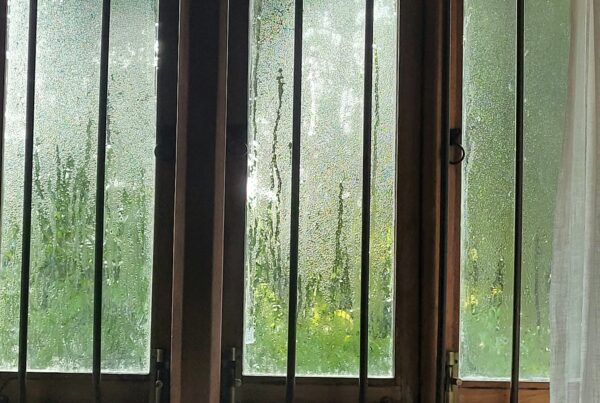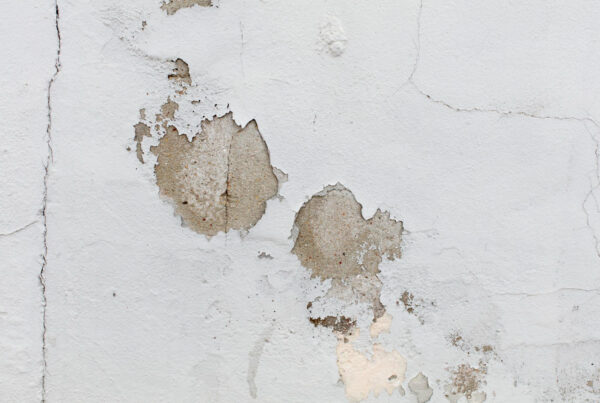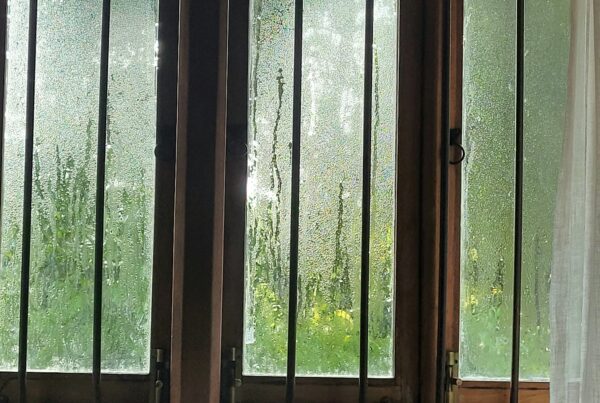Black mould poses health risks ranging from respiratory problems to allergic reactions. Understanding how to identify black mould, its health impacts, implementing prevention strategies, and knowing the best treatment approaches can help you tackle this problem.
How Harmful Is Black Mould?
Black mould, especially Stachybotrys chartarum, produces mycotoxins, which can cause health problems through mould spore inhalation and direct contact.
The World Health Organisation links indoor damp and mould exposure to ongoing respiratory problems. Black mould is potentially dangerous because its spores stay airborne for extended periods, entering the lungs and triggering inflammatory responses. Young children, elderly people, and those with respiratory conditions face the highest risk.
Identifying Black Mould in Your Home
Black mould appears as dark green or black patches with a slimy texture when growing and becomes powdery when dry. Unlike other moulds, black mould results in distinct circular patterns that spread from moisture sources.
Common locations for black mould growth
Black mould thrives in damp areas with poor ventilation where moisture in the air accumulates. Check bathrooms around showers, kitchens near sinks, basements with high humidity, and water-damaged areas. Condensation treatment helps to identify hidden mould behind walls and in ventilation systems.
Distinguishing features from other moulds
Black mould produces a strong, musty odour distinct from mildew’s sweeter smell. Growth patterns show dark centres with lighter edges; affected areas feel damp when surrounding surfaces are dry. Professional identification will confirm whether you are dealing with toxic black mould or less harmful varieties.
5 Key Prevention Measures Against Black Mould
These approaches can help limit the growth of black mould in a property.
1. Control indoor humidity below 50%
Dehumidifiers and available mould removers can help reduce moisture in the air and monitor it with humidity meters. Black mould cannot grow when the humidity stays low.
2. Fix water leaks immediately
Repairing dripping taps, pipes, and roof damage can prevent mould growth. Penetrating damp treatment focuses on identifying hidden leaks that cause damp and mould.
3. Ventilate moisture-prone areas properly
Install extractor fans in bathrooms and kitchens to ventilate effectively. Run fans during and 30 minutes after showers or cooking, removing excess moisture in the air.
4. Dry wet areas within 24 hours
Clean spills immediately. Fast drying prevents mould spores from germinating and creating mould issues.
5. Apply good drainage practices
Slope soil away from foundations to prevent water accumulation that causes rising damp. Clean gutters regularly to prevent overflow that creates damp and mould conditions.
Effective Mould on Walls Treatment Methods
Successful black mould removal requires the correct safety equipment and systematic treatment to stop mould and address visible growth and hidden spores.
DIY treatment for small areas
For patches under one square metre, wear N95 masks, gloves, and eye protection before attempting to remove mould. Do not dry brush – this releases dangerous mould spores. Mix one part bleach with ten parts water or use undiluted white vinegar. Spray affected areas, leave 15 minutes, then scrub with disposable brushes.
Dispose of contaminated materials in sealed bags. Dry completely and apply anti-mould paint to prevent regrowth. Monitor for returning growth, which may indicate deeper mould issues.
Professional treatment requirements
Large infestations over one square metre require professional treatment to get rid of mould completely. Specialists use HEPA filtration to capture airborne mould spores during removal. Industrial fungicides penetrate deeper than household products, killing embedded roots.
Professional treatment includes fixing moisture sources that prevent regrowth. Damp proofing services help address underlying dampness and rising damp, which can enable mould growth.
When Does Professional Mould Repair Become Necessary?
Professional intervention is important when black mould covers large areas, returns after DIY treatment, or appears in HVAC systems, spreading mould spores throughout properties.
Structural involvement
Mould penetrating plasterboard, insulation, or timber requires professional removal and assessment. Hidden growth in cavities needs specialist detection and treatment. Contaminated materials require safe disposal following regulations.
Health symptoms present
Seek professional help if family members show persistent respiratory symptoms from damp and mould exposure, allergic reactions worsen despite cleaning, or vulnerable individuals live in affected properties.
Insurance and property concerns
Professional repairs provide documentation for insurance claims and sales. Certified treatment helps to protect a property’s value and guarantees against regrowth. Mortgage lenders may require certification for properties with previous mould issues.
Protect Your Home from Black Mould with Professional Solutions
Black mould requires action to protect your and your loved ones’ well-being. We bring 30 years of experience with advanced methods to remove mould permanently. Our systematic approach identifies moisture sources, removes all growth, and implements prevention strategies to keep your home mould-free.
As Trustmark-endorsed specialists with insurance-backed guarantees, we provide certified mould treatment on walls and ceilings, protecting property and safeguarding your health. Contact our experts today for professional assessment and treatment.



